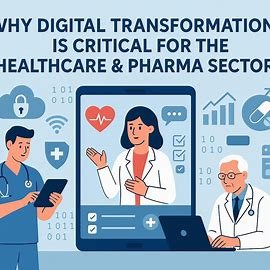The healthcare and pharmaceutical industry is entering a new era where digital transformation is no longer optional—it is essential. As technology reshapes patient expectations, clinical processes, and regulatory landscapes, companies that embrace digital solutions are better positioned to thrive. This article explores why digital transformation in healthcare is critical, its benefits, challenges, and strategies for successful adoption.
1. The Growing Need for Digital Transformation in Healthcare
1.1 Changing Patient Expectations
Patients today demand faster, more personalized, and accessible healthcare solutions. The rise of telemedicine, mobile health apps, and wearable devices is transforming patient behavior and expectations. According to recent surveys:
- 85% of patients prefer digital communication with healthcare providers.
- 60% expect personalized treatment recommendations based on data.
Healthcare and pharma organizations must integrate digital tools to meet these expectations. For instance, mobile apps allow patients to track medication adherence, monitor chronic conditions, and even schedule teleconsultations, bridging gaps in traditional care delivery.
1.2 Increasing Complexity in Pharma Operations
Pharmaceutical companies face growing complexity in drug development, clinical trials, regulatory compliance, and supply chain management. Manual processes and siloed systems hinder efficiency and innovation. Digital transformation streamlines operations through:
- Automated clinical trial management systems
- Data-driven predictive analytics for drug discovery
- Integrated supply chain platforms for real-time tracking
By leveraging digital tools, pharma companies can reduce costs, accelerate time-to-market, and improve operational efficiency.
2. Key Digital Technologies Transforming Healthcare & Pharma
2.1 Artificial Intelligence and Machine Learning
AI and ML are revolutionizing healthcare decision-making and pharma R&D. They enable faster, data-driven insights, predictive modeling, and risk assessment.
Examples in Practice:
| Area | Application | Benefit |
|---|---|---|
| Drug Discovery | Predicting molecular interactions | Reduces R&D time |
| Diagnostics | AI-powered imaging analysis | Higher accuracy |
| Personalized Treatment | Predictive patient response modeling | Improved outcomes |
AI also supports operational efficiency by identifying patterns in large datasets that humans cannot detect, helping pharma companies optimize trials and forecast demand more accurately.
2.2 Cloud Computing and Data Integration
Cloud platforms facilitate seamless access to patient records, research data, and collaboration tools. Benefits include:
- Centralized data management
- Scalability for growing datasets
- Secure, compliant storage for sensitive patient information
Example: A pharma company using a cloud-based platform can integrate global clinical trial data, allowing researchers to identify trends and adverse reactions in real-time.
2.3 IoT and Wearable Devices
Connected devices enable continuous patient monitoring, offering real-time insights into health status. Wearables can track vital signs, medication adherence, and chronic condition management.
Key Benefits:
- Enhanced remote patient monitoring
- Early detection of health complications
- Data collection for personalized treatment plans
3. Digital Transformation in Pharma: Real-World Applications
3.1 Improving Drug Discovery and Development
Traditional drug discovery is expensive, time-consuming, and prone to high failure rates. Digital transformation leverages AI, predictive analytics, and simulation technologies to accelerate discovery.
Impact:
- Reduced R&D timelines by up to 30%
- Lower operational costs through simulation instead of physical trials
- Improved identification of promising drug candidates
Case Study: A leading pharma company implemented AI-driven molecular modeling, reducing early-stage trial failures by 25%.
3.2 Enhancing Patient Engagement and Care
Digital transformation enables more personalized and proactive patient care. Tools such as mobile health apps, chatbots, and telemedicine platforms foster engagement and adherence.
Bullet Points of Benefits:
- Real-time appointment scheduling and reminders
- Remote consultations reducing hospital visits
- Tailored health education based on patient history
3.3 Streamlining Supply Chain and Logistics
A fully digitized supply chain ensures transparency, reduces counterfeit drugs, and optimizes inventory management. Blockchain and IoT can track drug shipments from manufacturing to pharmacies.
Example Table:
| Technology | Use Case | Benefit |
|---|---|---|
| Blockchain | Drug authentication | Prevents counterfeiting |
| IoT Sensors | Cold chain monitoring | Ensures drug safety |
| ERP Systems | Inventory management | Reduces shortages & waste |
4. Challenges to Digital Transformation
4.1 Data Security and Privacy Concerns
With more patient data stored digitally, cybersecurity becomes critical. HIPAA compliance and GDPR regulations require robust data protection mechanisms.
4.2 Resistance to Change
Healthcare professionals and staff may resist adopting new technologies due to lack of training or fear of disruption. Proper change management strategies and training programs are essential.
4.3 High Implementation Costs
Investing in digital infrastructure, AI systems, and cloud solutions requires significant capital. ROI may take time to materialize, requiring careful planning and phased implementation.
Mitigation Strategies:
- Pilot programs to test solutions
- Cloud-based solutions to reduce upfront costs
- Continuous staff training and support
5. Future Outlook and Strategic Recommendations
5.1 Embracing AI and Predictive Analytics
Pharma companies should invest in AI tools for predictive modeling in drug discovery and patient care. Predictive analytics can also identify population health trends, aiding public health planning.
5.2 Expanding Telemedicine and Remote Care
Digital platforms enable care delivery to remote and underserved populations. Telehealth adoption can improve patient outcomes while reducing costs associated with in-person visits.
5.3 Collaboration and Open Innovation
Partnering with tech firms, startups, and academic institutions accelerates digital transformation. Open innovation ecosystems can reduce development costs and enhance innovation pipelines.
5.4 Continuous Monitoring and Adaptation
Digital transformation is ongoing. Companies should monitor performance metrics, gather user feedback, and update systems regularly to remain competitive.
Conclusion: Driving Engagement Through Digital Transformation
Digital transformation in healthcare and pharma is more than just technology adoption—it’s a cultural shift that enables innovation, efficiency, and better patient outcomes. By embracing AI, IoT, cloud computing, and patient-centric digital tools, healthcare organizations can navigate challenges, seize opportunities, and lead the future of medicine.

Leave a Reply